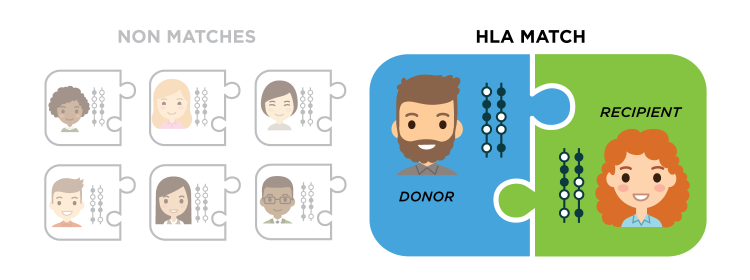Why Is a Close Match Important for a Transplant?
24th September 2021
Every year, millions of people lose their lives due to chronic diseases. Most of these diseases are incurable or have no standard treatment option. And in such difficult situations, stem cells are emerging as a potent therapeutic tool. Stem cells have already been approved for the treatment of more than 80 life-threatening diseases, including blood cancer and aplastic anemia.
However, stem cell transplant can prove beneficial to the patient only if he/she finds a perfect donor match. Why is donor-recipient matching important? Which factors determine the donor-recipient match? Well, the answer to these questions lies in the Human Leukocyte Antigen (HLA) typing. Read further to understand more about HLA matching.
HLA proteins
Human Leukocyte Antigen (HLA) is a protein marker present on the cells of the body. The HLA markers help our body's immune system to differentiate between self and non-self cells. There are three general groups of HLA - HLA-A, HLA-B, and HLA-DR. Each of these three groups is further sub-categorized into HLA proteins with a different numerical designation.

(Image adapted from giftoflife.org)
Fig.1. HLA Protein Match
When two individuals have the same set of HLA proteins, they are known as a 'good match.' In simpler terms, it means that the immune system of these two individuals is compatible with each other. The HLA proteins are inherited from the parents. If two siblings inherit the same set of HLA protein from their parents, they are called identical matches.
However, the siblings can sometimes inherit different combinations of HLA. Because half of the HLA set is inherited from the mother and half from the father, each sibling has a 25% chance (1 in 4 chances) of being a close HLA match.
Role of HLA proteins
HLA proteins help the immune system differentiate between the body's healthy cells (self-cells) and infectious or foreign cells (non-self cells). This prevents the immune system from killing the body's healthy cells.
In unmatched transplant surgery, the patient's immune system may identify the donor cells or organ as a foreign object and destroy it. Therefore, to avoid transplant rejection, the donor's HLA needs to match with the recipient.
However, finding a good match is difficult even among siblings. In such situations, typing and matching the HLA protein in advance can help the doctors determine the chances of transplant rejection.
HLA matching for a successful transplant
A close match between donor and recipient is essential for a successful transplant. HLA matching before a transplant can offer several benefits such as:
As stem cell therapy proves to be an effective treatment of several diseases, there is an increased need to recognize the role and significance of HLA-typing in a successful transplant.
References:
https://www.frontiersin.org/articles/10.3389/fimmu.2016.00575/full
Biocell® Copyright © 2026 All Rights Reserved.
Privacy Policy | Terms of Use
Biocell® products and services are offered by Regrow Biosciences Pvt. Ltd., directly or through authorized franchisees only. All payments must be made exclusively to Regrow Biosciences Pvt. Ltd. For verification, call +91 75069 4135. Thank you for your attention.
Biocell® Copyright © 2020
All Rights Reserved.
Biocell® products and services are offered by Regrow Biosciences Pvt. Ltd., directly or through authorized franchisees only. All payments must be made exclusively to Regrow Biosciences Pvt. Ltd. For verification, call +91 75069 4135. Thank you for your attention.
Download Brochure
Submitting...please wait. You will be redirected to the download page.